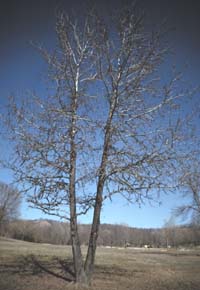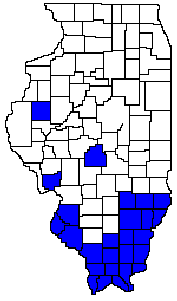 |
| Sweet
Gum (Liquidambar styraciflua)
Distribution
Map to Right |

Sweetgum is a large tree, up to 100 feet tall, with a pyramid-shaped crown. The trunk diameter sometimes exceeds three feet. It grows on a wide range of sites in Illinois, but occurs most frequently on bottomlands in the southern parts of the state.
Interesting
Facts
Liquidambar
styraciflua is commonly referred to as sweetgum because of the brownish
yellow sap it produces when the bark is cut. The name Liquidambar
is from the Latin liquidus, meaning fluid or liquid and the Arabic
ambar, referring to amber, both being references to the sap. The sweetgum
sap is also referred to as American styrax (hence the species name, styraciflua)
and some use it as a chewing gum.
Identifying Features
BarkUses
The bark is dark gray and forms scaly, regular ridges.
Leaves
The leaves are very distinctive. They are alternate, simple and star-shaped, with 5 to 7 points. The margins of the leaves are finely toothed.
Flowers
The male and female flowers are borne on the same tree closely packed into rounded clusters.
Fruits
The fruits are distinctive, spiny, long-stemmed balls that contain many seeds, most of which do not germinate. Songbirds and squirrels eat sweetgum seeds, and the fruits are sometimes painted and used as Christmas decorations.
The wood is hard and durable and is used for furniture, barrels, wooden bowls, cabinets, and interior finishing. In addition to using the sap as chewing gum, Native Americans and settlers used the sap to treat a wide variety of ailments in both humans and domestic animals. Native Americans used the roots and bark to treat skin disorders, diarrhea, fevers and other ailments. Sweetgum is frequently planted as an ornamental.